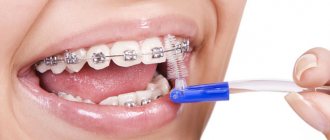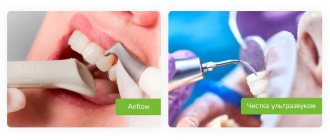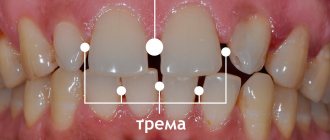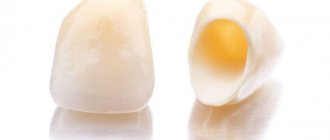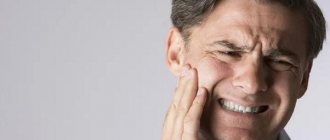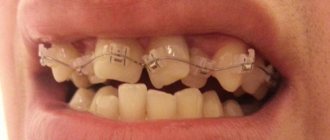Immediately after installation, braces can rub the oral mucosa and cause irritation. In most cases this is normal, you just need to be patient. If the discomfort does not go away and the symptoms intensify, you should see a doctor. In this article we will tell you what to do if your braces rub your cheeks, lips or tongue.
In this article
- When rubbing the mucous membrane with braces is the norm
- Braces rub cheeks: reasons
- What to do if braces rub your cheeks
- Wax for braces to prevent chafing
- Hygiene after installing braces
Braces are complex orthodontic structures consisting of many small parts. They are made from different materials - ceramics, plastic, sapphire or metal. Regardless of the type of system, the arc in it is always metal. It has memory and after installing braces it begins to return to the shape that was given to it during system modeling. She puts pressure on the teeth, gradually moving them in the desired direction. Due to this, the bite is slowly corrected and irregularities in the dentition are eliminated.
Braces place quite a lot of stress on the jaws. Immediately after their installation, a person feels discomfort in the oral cavity and even pain. Usually, unpleasant symptoms disappear within a few days or weeks.
People often complain that braces rub or scratch their lips and cheeks, causing small sores that bleed and hurt, especially when eating. In some cases, irritation of the tongue mucosa is observed, which can occur after the installation of lingual braces fixed on the inside of the dentition. Let's find out when such symptoms are normal and when they are not.
When rubbing the mucous membrane with braces is the norm
The oral mucosa is covered with a thin epithelial layer, penetrated by many blood vessels. Minor injuries, some products and orthodontic structures can disrupt its integrity and cause irritation. Braces are a foreign object for the body, which, when in contact with the mucous membrane, can cause a certain reaction. This happens especially often when teeth protrude strongly towards the cheeks or lips. In addition, the design itself is quite voluminous, so in some sense it increases the size of the jaw. Because of this, the contact of braces with the tissues of the oral cavity becomes more dense.
The mucous membrane recovers very quickly, without any treatment. Within a few days after installing the braces, a person ceases to feel any discomfort. If the problem does not go away, and the symptoms of damage to the mucous membrane intensify, you need to consult a doctor.
The following signs may be a reason for a visit:
- bleeding of the mucous membrane;
- pain while eating;
- the formation of ulcers and wounds covered with a white film.
If an infection gets into the wound, an inflammatory process will begin. Therefore, if you are concerned about several of the listed signs, do not try to eliminate them yourself. Most likely, the cause of these symptoms is not related to adaptation.
Gum inflammation
During and after orthodontic treatment, the patient begins to notice that while wearing braces, his gums have receded. Inflammation of soft tissues occurs due to poor dental care, lack of vitamins or incorrectly installed orthodontic system. You also need to understand that after tooth extraction there may also be inflammation of the gums.
In rare cases, a complication of wearing braces is gum recession and exposure of tooth roots.
In most cases, the inflammatory process in the gums while wearing braces begins due to poor hygiene. Braces make the cleaning process more difficult, which often leads to plaque deposits and tartar formation. As a result, problems begin, the gums bleed and hurt. The same symptoms can be observed after braces are removed.
A more rare reason is incorrect installation of the orthodontic system or its manufacturing errors. In these cases, braces can injure the gums, after which inflammation begins. If, some time after installing an orthodontic system, you notice that your gums are swollen, pain, and bleeding appear, then it is better to visit an orthodontist. This is necessary to eliminate the possibility of incorrect position of the braces.
A similar situation can be observed after braces are removed for the same reason - weakening of the gums occurs as a result of the accumulation of plaque, which is a breeding ground for various bacteria and pathogenic microorganisms.
It is important to recognize inflammation in the early stages and go to the orthodontist so that the doctor can prescribe treatment. When wearing braces, it is important to regularly brush your teeth twice a day and after every meal, and the use of an irrigator is recommended.
Braces rub cheeks: reasons
There are four possible reasons why braces chafe your cheeks, lips, and tongue. Among them:
- Error when installing the arch of the orthodontic structure. The orthodontist may incorrectly trim or bend the archwire, making it too long. As a result, it begins to scratch the tissues of the oral cavity. The problem is eliminated by partially dismantling the system and reinstalling the arc.
- The lock has come unglued from the enamel. One of the main parts of the structure is the locks, which are fixed to the tooth surface using dental cement. If one of the locks has lost contact with the enamel and become detached, it will most likely rub against your cheek or lip. This rarely happens, since the fixation of the braces should be as tight as possible so that they do not move even as a result of pressure. This may lead to incorrect correction. However, the likelihood of such a complication still exists, albeit low.
- The arch of the braces jumped out of the slots of the locks. This problem also occurs rarely. The reason for its appearance is an error when installing braces or non-compliance with the rules for wearing them. Thus, a person may press too hard on the system with a toothbrush or damage it when consuming hard foods, such as carrots. If the arch from the braces jumps out of the grooves, it begins to come into contact with the mucous membrane and rub it.
- Allergy to construction material. Sores, wounds, bleeding and other symptoms may be the result of an allergic reaction. Often it occurs on some metal. In this case, it is necessary to reinstall the system, and you will have to replace it with plastic, sapphire or ceramic. You may need to give up braces in favor of aligners.
In some cases, the adaptation period is delayed, which is associated with the individual characteristics of the body, for example, increased sensitivity of the mucous membrane. To reduce the risk of developing inflammatory diseases, it is recommended to carefully observe the rules of hygiene and eat right.
Rules for using protection when wearing braces
Using protective plates is not particularly difficult at any age. The main recommendations of dentists are to install protection on a clean and dried surface of the gums and tooth enamel. By following the developed application technique, you can extend the service life and increase the efficiency of using silicone strips.
The algorithm for forming a protective system is as follows:
- cleaning the oral cavity from food debris and removing plaque;
- drying and disinfection of the gluing area;
- collecting the required amount of material and heating it in your hands until soft;
- uniform and dense distribution of the composition over the surface.
The standard packaging contains a sufficient number of silicone plates, allowing them to be used for a long time. Dentists advise regularly updating the protective layer - prolonged wear can cause the accumulation of pathogenic infections. The total duration of getting used to the brace system is limited to two to three weeks, after which the use of protection loses practical meaning.
By adhering to medical recommendations, using certified materials and regularly seeing a dentist, you can minimize the negative sensations and effects caused by the installation of a corrective braces system at first.
What to do if braces rub your cheeks
If discomfort in the oral cavity does not go away after installing orthodontic braces, you will need the help of a specialist. Depending on the cause of the problem, he will select a method to eliminate it:
- glue the detached lock to the tooth surface, having previously removed the old glue with a solvent;
- will cut off both edges, bend and reinstall an arch that is too long;
- will put the arch in place if it has jumped out of the grooves due to the patient violating the rules of wearing braces;
- will replace the arc with a product made of a different material if the discomfort is caused by an allergy.
It is also necessary to help the patient quickly adapt to the design. To do this, he is prescribed special gels and ointments that can be used at home. If ulcers form, the doctor will select a healing or anti-inflammatory ointment to prevent the spread of infection.
Using wax
Before the advent of high-quality silicone protection, dentists recommended that patients use wax pads for similar purposes. Practice has shown that wax, in comparison with silicone, has a number of disadvantages, including:
- difficulty in removing the structure - wax particles can remain on the elements of the dentition;
- Average quality of fastening - silicone fits more tightly and does not change its position during operation.
Medical studies have proven that silicone is more reliable and of higher quality. However, this conclusion does not exclude the possibility of using wax protection in cases where an alternative is not available.
Wax for braces to prevent chafing
If braces rub the cheek, the dentist may prescribe orthodontic wax - a special composition that is applied to the structure to protect the mucous membrane from rubbing. The composition of such products is hypoallergenic, so they are suitable for all patients. Wax is recommended to be used not only during the adaptation period, but also after tightening the braces. It should be used according to the instructions:
- Dry the part of the structure that will be waxed using cotton swabs.
- Tear off a small piece of the mixture, warm it with your fingers and roll it into a small ball.
- Attach it to the protruding part of the staples using light pressure (the wax should not be under the metal elements of the structure).
Before eating, you need to remove the wax from the braces with a brush, cotton swab or brush. But nothing bad will happen even if you swallow a little of this product. It is absolutely safe for health, including for children.
If your braces continue to scratch your cheek or lips even with wax, the system may need to be removed. The need for this will be determined by an examination.
Modern drugs
To reduce discomfort when braces rub, you can use an antisthetic. It can be purchased at the pharmacy in the form of a gel or rinse. This remedy will relieve pain for several hours.
It is also convenient that you can buy an antisthetic in almost any pharmacy, and it is issued without a doctor’s prescription due to the absence of significant contraindications.
The most common products are Colgate Orabase and Orajel.
How to use these tools is described in detail in the attached instructions. It is better to study allergic contraindications before using it.
Hygiene after installing braces
After installing braces, the requirements for oral hygiene increase, especially during the period of adaptation to the system. If you don't brush your teeth or do it poorly, germs can get into the wounds caused by rubbing. Due to the infection, treatment will be delayed. It is possible that you will have to remove the staples, treat the pathology and put them back on.
To prevent this, use special hygiene products to care for braces: brushes, dental floss, mouthwash with antibacterial properties and a special brush with V-shaped bristles.
Orthodontists also recommend cleaning your mouth 2-3 times a week with an irrigator. It is necessary to select devices with attachments designed for the care of orthodontic systems, for example, Little Doctor International Ltd Aquajet LD-A7 and Donfeel Donfeel OR-820D Compact. Before purchasing brushes and other hygiene products, consult your doctor.
General overview
The anatomical structure of the inner surface of the cheeks and lips is characterized by the presence of a capillary network that provides tissue nutrition. Regular contact with solid foreign bodies occurring in the same place leads to gradual deformation of the protective layer, and, as a result, damage to the internal structure. The source of the problem can be any element, be it locks or ligatures of braces, or a crown that has shifted under the pressure of a power arc.
Traditionally, it takes several days to adapt to a newly installed or reactivated corrector, after which the body gets used to it and the patient stops noticing the foreign structure. Minimally damaged areas quickly regenerate due to lysozyme contained in saliva - the enzyme not only promotes recovery, but also prevents the entry of pathogenic microorganisms.
Alarming symptoms
If the irritation does not go away after a few days, and the resulting abrasions cause physical discomfort, it is recommended not to delay visiting your doctor for a re-examination. Prolonged exposure to mucous tissue leads to the formation of foci of erosion, the formation of ulcers and constant bleeding, and also causes pain, which increases in proportion to the load on the jaw region.
Modern models of braces differ markedly from the correctors used in orthodontics in the last century. Modeling and processing technologies guarantee anatomical conformity to the configuration, and ensure the smoothness of the surface of the bases and fastenings. Uncomfortable sensations caused by constant rubbing indicate the presence of deviations from the norm, which can be caused by the following factors:
- An increase in the length of the power arc due to changes in the shape of the dentition;
- Failure to comply with medical recommendations during hygiene procedures;
- Departure of ligatures or braces from the enamel coating;
- Displacement of crowns located near the edentulous area.
It is strongly not recommended to ignore negative symptoms - pain, bleeding, swelling of tissues, since the development of an abnormal condition leads to complications. The presence of an affected area in the oral cavity increases the likelihood of infection, which results in a weakening of the periodontal structure, as well as the risk of the formation of complex pathologies.
